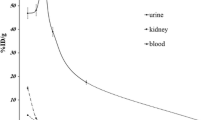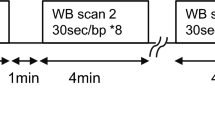Abstract
Purpose
[18 F]VM4-037 has been developed as a positron emission tomography (PET) imaging marker to detect carbonic anhydrase IX (CA-IX) overexpression and is being investigated for use as a surrogate marker for tissue hypoxia. The purpose of this study was to determine the biodistribution and estimate the radiation dose from [18 F]VM4-037 using whole-body PET/CT scans in healthy human volunteers.
Procedures
Successive whole-body PET/CT scans were performed after intravenous injection of [18 F]VM4-037 in four healthy humans. The radiotracer uptakes in different organs were determined from the analysis of the PET scans. Human radiation doses were estimated using OLINDA/EXM software.
Results
High uptake of [18 F]VM4-037 was observed in the liver and kidneys, with little clearance of activity during the study period, with mean standardized uptake values of ~35 in liver and ~22 in kidneys at ~1 h after injection. The estimated effective dose was 28 ± 1 μSv/MBq and the absorbed doses for the kidneys and liver were 273 ± 31 and 240 ± 68 μGy/MBq, respectively, for the adult male phantom. Hence, the effective dose would be 10 ± 0.5 mSv for the anticipated injected activity of 370 MBq, and the kidney and liver doses would be 101 ± 11 and 89 ± 25 mGy, respectively.
Conclusions
[18 F]VM4-037 displayed very high uptake in the liver and kidneys with little clearance of activity during the study period, resulting in these organs receiving the highest radiation doses among all bodily organs. Though the effective dose and the organ doses are within the limits considered as safe, the enhanced uptake of [18 F]VM4-037 in the kidneys and liver will make the compound unsuitable for imaging overexpression of CA-IX in those two organs. However, the tracer may be suitable for imaging overexpression of CA-IX in lesions in other regions of the body such as in the lungs or head and neck region.




Similar content being viewed by others
References
Potter C, Harris AL (2004) Hypoxia inducible carbonic anhydrase IX, marker of tumour hypoxia, survival pathway and therapy target. Cell Cycle 3:164–167
Pastorek J, Pastorekova S (2004) Cancer-related carbonic anhydrase isozymes and their inhibition. CRC, Boca Raton
Ivanov S, Liao SY, Ivanova A et al (2001) Expression of hypoxia-inducible cell-surface transmembrane carbonic anhydrases in human cancer. Am J Pathol 158:905–919
Winum JY, Rami M, Scozzafava A et al (2008) Carbonic anhydrase IX: a new druggable target for the design of antitumor agents. Med Res Rev 28:445–463
Pastorekova S, Parkkila S, Zavada J (2006) Tumor-associated carbonic anhydrases and their clinical significance. Adv Clin Chem 42:167–216
Potter CP, Harris AL (2003) Diagnostic, prognostic and therapeutic implications of carbonic anhydrases in cancer. Br J Cancer 89:2–7
Wykoff CC, Beasley NJ, Watson PH et al (2000) Hypoxia-inducible expression of tumor-associated carbonic anhydrases. Cancer Res 60:7075–7083
Chen L, Zhang Z, Kolb HC et al (2012) (1)(8)F-HX4 hypoxia imaging with PET/CT in head and neck cancer: a comparison with (1)(8)F-FMISO. Nucl Med Commun 33:1096–1102
Ilie M, Mazure NM, Hofman V et al (2010) High levels of carbonic anhydrase IX in tumour tissue and plasma are biomarkers of poor prognostic in patients with non-small cell lung cancer. Br J Cancer 102:1627–1635
Jarvela S, Parkkila S, Bragge H et al (2008) Carbonic anhydrase IX in oligodendroglial brain tumors. BMC Cancer 8:1
Bui MH, Seligson D, Han KR et al (2003) Carbonic anhydrase IX is an independent predictor of survival in advanced renal clear cell carcinoma: implications for prognosis and therapy. Clin Cancer Res 9:802–811
Chia SK, Wykoff CC, Watson PH et al (2001) Prognostic significance of a novel hypoxia-regulated marker, carbonic anhydrase IX, in invasive breast carcinoma. J Clin Oncol 19:3660–3668
Loncaster JA, Harris AL, Davidson SE et al (2001) Carbonic anhydrase (CA IX) expression, a potential new intrinsic marker of hypoxia: correlations with tumor oxygen measurements and prognosis in locally advanced carcinoma of the cervix. Cancer Res 61:6394–6399
Kaanders JH, Wijffels KI, Marres HA et al (2002) Pimonidazole binding and tumor vascularity predict for treatment outcome in head and neck cancer. Cancer Res 62:7066–7074
Tanaka N, Kato H, Inose T et al (2008) Expression of carbonic anhydrase 9, a potential intrinsic marker of hypoxia, is associated with poor prognosis in oesophageal squamous cell carcinoma. Br J Cancer 99:1468–1475
Patard JJ, Fergelot P, Karakiewicz PI et al (2008) Low CAIX expression and absence of VHL gene mutation are associated with tumor aggressiveness and poor survival of clear cell renal cell carcinoma. Int J Cancer 123:395–400
McDonald PC, Winum JY, Supuran CT, Dedhar S (2012) Recent developments in targeting carbonic anhydrase IX for cancer therapeutics. Oncotarget 3:84–97
Divgi CR, Uzzo RG, Gatsonis C et al (2013) Positron emission tomography/computed tomography identification of clear cell renal cell carcinoma: results from the REDECT trial. J Clin Oncol 31:187–194
Neri D, Supuran CT (2011) Interfering with pH regulation in tumours as a therapeutic strategy. Nat Rev Drug Discov 10:767–777
Supuran CT (2008) Carbonic anhydrases: novel therapeutic applications for inhibitors and activators. Nat Rev Drug Discov 7:168–181
Kolb HC, Walsh JC, Dhanalakshmi K, et al. (2010) Development of molecular imaging probes for carbonic anhydrase-IX using click chemistry. US Patent US20100317842-A1. Issued Dec 16, 2010
Stabin MG, Sparks RB, Crowe E (2005) OLINDA/EXM: the second-generation personal computer software for internal dose assessment in nuclear medicine. J Nucl Med 46:1023–1027
Doss M, Kolb HC, Zhang JJ et al (2012) Biodistribution and radiation dosimetry of the integrin marker 18 F-RGD-K5 determined from whole-body PET/CT in monkeys and humans. J Nucl Med 53:787–795
FDA (2010) Guidance for industry and researchers. The Radioactive Drug Research Committee: Human Research Without an Investigational New Drug Application. FDA, Silver Spring, MD
Stabin M, Stubbs J, Toohey R (1996) Radiation dose estimates for radiopharmaceuticals, NUREG/CR-6345
Hasannejad H, Takeda M, Taki K et al (2004) Interactions of human organic anion transporters with diuretics. J Pharmacol Exp Ther 308:1021–1029
Pastorekova S, Parkkila S, Pastorek J, Supuran CT (2004) Carbonic anhydrases: current state of the art, therapeutic applications and future prospects. J Enzym Inhib Med Chem 19:199–229
Pastorekova S, Casini A, Scozzafava A et al (2004) Carbonic anhydrase inhibitors: the first selective, membrane-impermeant inhibitors targeting the tumor-associated isozyme IX. Bioorg Med Chem Lett 14:869–873
Emara M, Turner AR, Allalunis-Turner J (2010) Hypoxic regulation of cytoglobin and neuroglobin expression in human normal and tumor tissues. Cancer Cell Int 10:33
Takacova M, Bartosova M, Skvarkova L et al (2013) Carbonic anhydrase IX is a clinically significant tissue and serum biomarker associated with renal cell carcinoma. Oncol Lett 5:191–197
Betof AS, Rabbani ZN, Hardee ME et al (2012) Carbonic anhydrase IX is a predictive marker of doxorubicin resistance in early-stage breast cancer independent of HER2 and TOP2A amplification. Br J Cancer 106:916–922
Kim SJ, Rabbani ZN, Dewhirst MW et al (2005) Expression of HIF-1alpha, CA IX, VEGF, and MMP-9 in surgically resected non-small cell lung cancer. Lung Cancer 49:325–335
Kim SJ, Rabbani ZN, Vollmer RT et al (2004) Carbonic anhydrase IX in early-stage non-small cell lung cancer. Clin Cancer Res 10:7925–7933
Li Y, Wang H, Oosterwijk E et al (2009) Expression and activity of carbonic anhydrase IX is associated with metabolic dysfunction in MDA-MB-231 breast cancer cells. Cancer Invest 27:613–623
Wolburg H, Noell S, Fallier-Becker P et al (2012) The disturbed blood–brain barrier in human glioblastoma. Mol Aspects Med 33:579–589
McDonald PC, Winum JY, Supuran CT, Dedhar S (2012) Recent developments in targeting carbonic anhydrase IX for cancer therapeutics. Oncotarget 3:84–97
Doss M, Zhang JJ, Belanger MJ et al (2010) Biodistribution and radiation dosimetry of the hypoxia marker 18 F-HX4 in monkeys and humans determined by using whole-body PET/CT. Nucl Med Commun 31:1016–1024
Haubner R, Kuhnast B, Mang C et al (2004) [18 F]Galacto-RGD: synthesis, radiolabeling, metabolic stability, and radiation dose estimates. Bioconjug Chem 15:61–69
Acknowledgments
We wish to thank the nuclear medicine staff at the PET center including Donna Mosley for performing the PET/CT scans. We also wish to thank Mary Benetz and the staff from the Protocol Management Office for help with this research protocol. The help of the staff from Clinical Research Unit and Protocol Support Laboratory is gratefully acknowledged. The study was conducted at Fox Chase Cancer Center under a research contract with Siemens Molecular Imaging Inc. The study is registered in ClinicalTrials.gov with the identifier NCT00884520 and IND number 104438.
Conflict of Interest
Joseph C. Walsh and Zhihong Zhu are employees of Siemens Molecular Imaging Inc. Hartmuth C. Kolb, Vani P. Mocharla, and Michael Haka were previously employees of Siemens Molecular Imaging Inc. at the time of the work described here. Fox Chase Cancer Center performed the research work described in this paper under a research contract with Siemens Molecular Imaging Inc. None of the authors received any additional compensation for performing this work.
Author information
Authors and Affiliations
Corresponding author
Rights and permissions
About this article
Cite this article
Doss, M., Kolb, H.C., Walsh, J.C. et al. Biodistribution and Radiation Dosimetry of the Carbonic Anhydrase IX Imaging Agent [18 F]VM4-037 Determined from PET/CT Scans in Healthy Volunteers. Mol Imaging Biol 16, 739–746 (2014). https://doi.org/10.1007/s11307-014-0730-7
Published:
Issue Date:
DOI: https://doi.org/10.1007/s11307-014-0730-7




